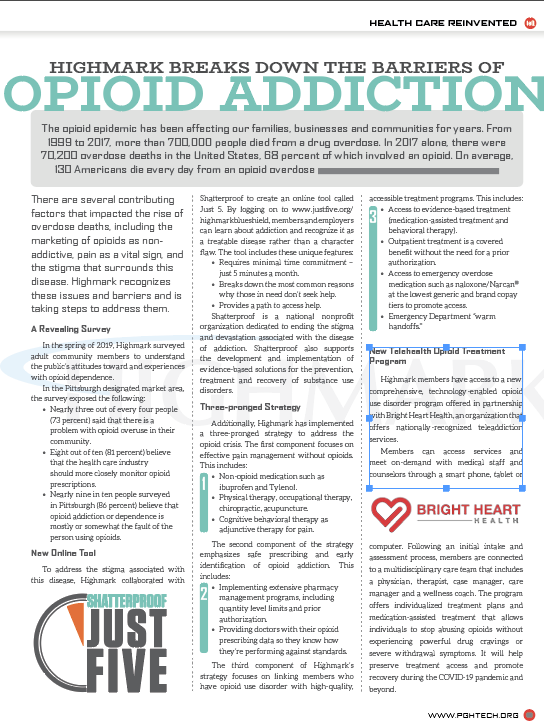Highmark Breaks Down the Barriers of Opioid Addiction
 The opioid epidemic has been affecting our families, businesses and communities for years. From 1999 to 2017, more than 700,000 people died from a drug overdose. In 2017 alone, there were 70,200 overdose deaths in the United States, 68 percent of which involved an opioid. On average, 130 Americans die every day from an opioid overdose (CDC https://www.cdc.gov/drugoverdose/epidemic/index.html)
The opioid epidemic has been affecting our families, businesses and communities for years. From 1999 to 2017, more than 700,000 people died from a drug overdose. In 2017 alone, there were 70,200 overdose deaths in the United States, 68 percent of which involved an opioid. On average, 130 Americans die every day from an opioid overdose (CDC https://www.cdc.gov/drugoverdose/epidemic/index.html)
There are several contributing factors that impacted the rise of overdose deaths, including the marketing of opioids as non-addictive, pain as a vital sign, and the stigma that surrounds this disease. Highmark recognizes these issues and barriers and is taking steps to address them.
A Revealing Survey
In the spring of 2019, Highmark surveyed adult community members to understand the public’s attitudes toward and experiences with opioid dependence.
In the Pittsburgh designated market area, the survey exposed the following:
• Nearly three out of every four people (73 percent) said that there is a problem with opioid overuse in their community.
• Eight out of ten (81 percent) believe that the health care industry should more closely monitor opioid prescriptions.
• Nearly nine in ten people surveyed in Pittsburgh (86 percent) believe that opioid addiction or dependence is mostly or somewhat the fault of the person using opioids.
New Online Tool
To address the stigma associated with this disease, Highmark collaborated with Shatterproof to create an online tool called Just 5. By logging on to www.justfive.org/highmarkblueshield, members and employers can learn about addiction and recognize it as a treatable disease rather than a character flaw. The tool includes these unique features:
• Requires minimal time commitment – just 5 minutes a month.
• Breaks down the most common reasons why those in need don’t seek help.
• Provides a path to access help.
Shatterproof is a national nonprofit organization dedicated to ending the stigma and devastation associated with the disease of addiction. Shatterproof also supports the development and implementation of evidence-based solutions for the prevention, treatment and recovery of substance use disorders.
Three-pronged Strategy
Additionally, Highmark has implemented a three-pronged strategy to address the opioid crisis. The first component focuses on effective pain management without opioids. This includes:
• Non-opioid medication such as ibuprofen and Tylenol.
• Physical therapy, occupational therapy, chiropractic, acupuncture.
• Cognitive behavioral therapy as adjunctive therapy for pain.
The second component of the strategy emphasizes safe prescribing and early identification of opioid addiction. This includes:
• Implementing extensive pharmacy management programs, including quantity level limits and prior authorization.
• Providing doctors with their opioid prescribing data so they know how they’re performing against standards.
The third component of Highmark’s strategy focuses on linking members who have opioid use disorder with high-quality, accessible treatment programs. This includes:
• Access to evidence-based treatment (medication-assisted treatment and behavioral therapy).
• Outpatient treatment is a covered benefit without the need for a prior authorization.
• Access to emergency overdose medication such as naloxone/Narcan® at the lowest generic and brand copay tiers to promote access.
• Emergency Department “warm handoffs."
New Telehealth Opioid Treatment Program
Highmark members have access to a new, comprehensive, technology-enabled opioid use disorder program offered in partnership with Bright Heart Health, an organization that offers nationally-recognized teleaddiction services.
Members can access services and meet on-demand with medical staff and counselors through a smart phone, tablet or computer. Following an initial intake and assessment process, members are connected to a multidisciplinary care team that includes a physician, therapist, case manager, care manager and a wellness coach. The program offers individualized treatment plans and medication-assisted treatment that allows individuals to stop abusing opioids without experiencing powerful drug cravings or severe withdrawal symptoms. It will help preserve treatment access and promote recovery during the COVID-19 pandemic and beyond.